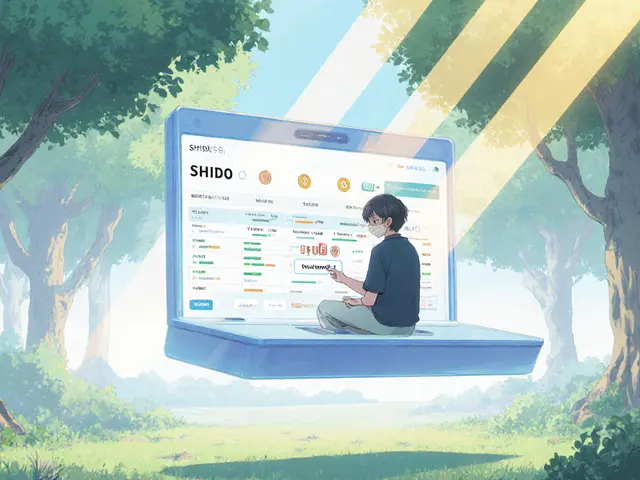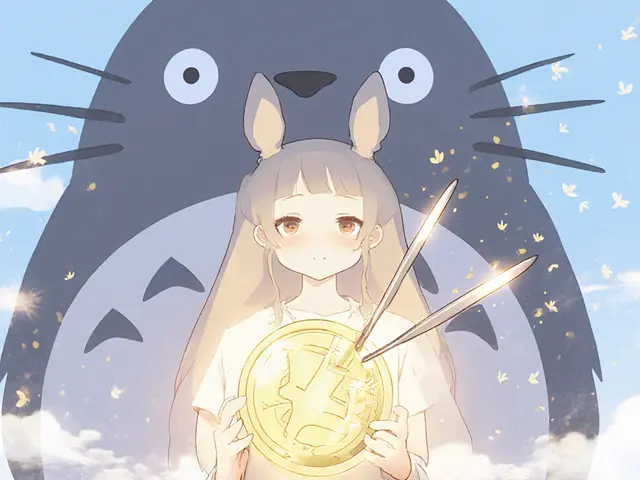HONEY Earnings Calculator
Earnings Calculator
How It Works
Based on data from active contributors:
- Reddit user "MapRider2023" earned 14,500 HONEY for 1,200 miles
- This equals approximately $0.13 per mile at current prices
- Earnings vary based on image quality and coverage gaps
- Token rewards may fluctuate by up to 40% month-over-month
Note: Current market data as of October 2024. Actual earnings may vary due to network demand and token price volatility.
Estimated Earnings
HONEY Tokens: 0
USD Value: $0.00
Estimated per mile: $0.00
Key Takeaways
- Honey (HONEY) is the native SPL token of the Hivemapper network, built on Solana.
- It rewards dash‑cam contributors and fuels map‑data purchases for businesses.
- Supply is capped at 10 billion, with a "burn‑and‑mint" mechanism to balance demand.
- As of October 2024 the token trades around $0.011 with a market cap near $55 million.
- Future plans include DAO governance, drone‑mapping pilots, and deeper ties to autonomous‑vehicle makers.
If you’ve seen the ticker Honey crypto on an exchange and wondered what it actually does, you’re not alone. Unlike meme‑coins that exist solely as speculative assets, HONEY tries to solve a real‑world problem: keeping digital maps up‑to‑date without relying on a single corporate giant. Below is a step‑by‑step walk‑through of the token’s purpose, tech stack, economics, market performance, and where it might be headed.
What Is Honey (HONEY)?
When you first encounter the token, the simplest definition helps clear the fog:
Honey (HONEY) is a native SPL token that powers the Hivemapper decentralized mapping network. It lives on the Solana blockchain and follows a fixed 10 billion‑token supply.
The network launched in early November 2022, and the token was minted in block 158569587. HONEY serves two core roles:
- Rewarding contributors who capture road‑level imagery with a dedicated dash‑cam.
- Paying for map‑data queries from businesses, developers, and autonomous‑vehicle platforms.
Technical Foundations
Understanding the tech stack explains why HONEY can handle millions of map‑updates daily.
- Blockchain: Solana, a high‑throughput layer‑1, processes 50 000-65 000 tx/sec at sub‑$0.001 fees. This keeps contributor payouts and data‑purchase transactions cheap and fast.
- Token Standard: HONEY is an SPL token (Solana Program Library), meaning it follows the same contract interface as other Solana assets.
- Smart‑contract address: Verified on Solscan as the official contract (exact address omitted for brevity).
- No staking: Unlike many DeFi tokens, HONEY does not offer native staking. Instead, rewards are minted directly from the network’s “burn‑and‑mint” cycle.
Tokenomics - Supply, Demand, and the Burn‑and‑Mint Loop
The economics are where HONEY gets interesting. The token has a hard cap of 10 billion, but only a portion circulates at any given time.
When a business requests map tiles, it must burn a set amount of HONEY, sending those tokens to an irrecoverable address. A predetermined fraction of the burned amount is then re‑minted and distributed to active contributors based on the Global Map Progress metric. This creates a self‑balancing loop: higher data demand triggers more burns, which leads to more minting and thus more incentives for contributors.
Current allocations (as of October 2024):
- 4 billion earmarked for contributor rewards.
- ~2 billion held by the Hivemapper Foundation for ecosystem grants and future DAO treasury.
- Remaining tokens allocated to team, advisors, and early investors (vested over 4 years).
How Contributors Earn HONEY
Anyone can become a data collector, but the process is hardware‑heavy.
- Purchase the Hivemapper Dashcam Pro (≈ $299).
- Complete KYC in the Hivemapper mobile app (average 2.7 hours setup).
- Drive on public roads while the dash‑cam streams video to the decentralized network.
- Earn HONEY proportional to distance driven, image quality, and coverage gaps filled.
Reddit user “MapRider2023” reported earning 14 500 HONEY for 1 200 miles - roughly $0.13 per mile at the October 2024 price. However, community surveys also flag “reward volatility” as a common pain point; payouts can swing 40 % month‑over‑month if network coverage needs shift.

Business Use Cases - Buying Map Data
For developers and enterprises, HONEY functions as a utility token.
- API access: Companies pay per tile or per gigabyte via the Hivemapper API. Payments are settled in HONEY, which is then burned.
- Autonomous‑vehicle fleets: Real‑time road‑level updates (e.g., construction, lane changes) are especially valuable for self‑driving stacks.
- Drone mapping pilots: Partnered with Skydio in Oct 2024 to test aerial data collection, expanding the token’s utility beyond ground vehicles.
Compared to Google Maps pricing ($0.50-$2.00 per 1 000 tiles), Hivemapper aims to undercut costs once the ecosystem scales, though current liquidity constraints keep transaction fees higher than traditional fiat APIs.
Market Snapshot (Oct 2024)
| Metric | Value |
|---|---|
| Current price (CoinGecko) | $0.01096 |
| 24‑hour volume | $916,624 |
| Circulating supply (average of sources) | 4.8 billion HONEY |
| Market cap (average) | $≈ 53 million |
| Rank by market cap | #666 (CoinGecko) |
Price volatility is noticeable: predictions range from $0.008 (bearish) to $0.15 (bullish) for 2025. Analyst median target sits around $0.042, implying a potential 283 % upside.
How HONEY Stacks Up Against Other DePIN Tokens
| Token | Primary Use Case | Blockchain | Max Supply | Current Price |
|---|---|---|---|---|
| Honey (HONEY) | Decentralized mapping | Solana | 10 B | $0.011 |
| Helium (HNT) | Wireless coverage | Solana | 1 B | $2.35 |
| DIMO (DIMO) | Vehicle telemetry | Ethereum (Layer‑2) | 2 B | $0.42 |
Honey’s niche is narrower than Helium’s network‑infrastructure focus, but it offers a tangible, data‑driven product that can directly monetize road footage. The trade‑off is lower liquidity - daily volume sits near $6 million versus Helium’s $200 million.
Pros, Cons, and Common Pitfalls
Every token has strengths and weaknesses. Below is a distilled list for quick reference.
- Pros:
- Real‑world utility - maps are needed everywhere.
- Low transaction fees thanks to Solana.
- Burn‑and‑mint design ties supply to actual demand.
- Growing contributor base (≈ 45 k active users Q3 2024).
- Cons:
- Hardware barrier - you need a $299 dash‑cam.
- Reward volatility frustrates contributors.
- Liquidity is modest; large trades can impact price.
- Adoption still early - only 47 countries have coverage.

Expert Opinions - What the Community Says
Crypto analysts are split. Galaxy Digital’s Alex Thorn acknowledges the token’s genuine utility but warns of “adoption hurdles.” Lark Davis calls the current valuation “disconnected” from revenue, while CoinDataFlow’s bullish model predicts $1.47 per token by 2025. The consensus among 12 research firms (The Block, Messari, Delphi, etc.) lands on a median target of $0.042, reflecting cautious optimism.
Getting Started - How to Acquire and Use HONEY
- Set up a Solana‑compatible wallet (Phantom, Solflare, or Ledger).
- Buy HONEY on a supported exchange (KuCoin, Gate.io, or Binance). Ensure you check the listed contract address.
- If you’re a contributor, order the Hivemapper Dashcam Pro, complete KYC, and register your wallet address in the app.
- Businesses should read the API docs, generate an API key, and fund a wallet with enough HONEY to cover projected data queries.
Remember: because the token uses a burn mechanism, always keep a buffer of extra HONEY to avoid transaction failures.
Future Roadmap - Where Is HONEY Heading?
The Hivemapper Foundation has laid out an ambitious plan through 2025:
- Launch a DAO for token‑holder governance (Q1 2025).
- Expand coverage to 100 countries by end‑2025.
- Integrate directly with autonomous‑vehicle manufacturers (target Q2 2025).
- Roll out drone‑based aerial mapping, adding a new data stream and fresh reward dynamics.
- Iterate the reward algorithm (Improvement Proposal #17) to weigh data‑quality more heavily.
If these milestones hit, the token’s utility and demand could climb sharply, making the current low price a potential entry point for long‑term believers.
Frequently Asked Questions
What blockchain does HONEY run on?
HONEY is an SPL token on the Solana blockchain, benefiting from high throughput and negligible transaction fees.
How can I earn HONEY without buying a dash‑cam?
Currently the primary earn‑method is through the Hivemapper Dashcam Pro. Some community contests and bug‑bounty programs distribute small token amounts, but they are not a reliable income source.
Why does HONEY need to be burned?
Burning creates scarcity that matches actual demand for map data. When a business consumes data, the burned tokens are partially re‑minted as rewards, keeping the ecosystem balanced.
Is HONEY a good long‑term investment?
Opinions vary. If the mapping network reaches mass adoption and the DAO governance succeeds, the token could appreciate. However, the speculative nature, modest liquidity, and hardware barrier make it a higher‑risk play.
Where can I buy HONEY?
Major exchanges that list HONEY include KuCoin, Gate.io, and Binance. Always verify the contract address before depositing.
Whether you’re a driver looking to monetize your commute or a tech firm hunting affordable, up‑to‑date map data, Honey (HONEY) offers a fresh take on tokenized infrastructure. Keep an eye on the DAO rollout and the upcoming drone‑mapping pilot - those could be the catalysts that push the token from niche to mainstream.






Hailey M.
March 20, 2025 AT 15:35 PMOh great, another token that wants to map the world, as if we needed more GPS drama. 😂
Irish Mae Lariosa
March 29, 2025 AT 21:48 PMThe Honey (HONEY) token presents itself as a utility layer for decentralized mapping, yet the underlying economics raise several concerns.
Its burn‑and‑mint mechanism, while theoretically elegant, introduces a feedback loop that can amplify volatility during periods of low data demand.
Because the token resides on Solana, transaction fees remain negligible, but the network’s recent outages raise questions about reliability for mission‑critical map updates.
The fixed supply of ten billion tokens sounds appealing, however only roughly half of that amount is currently circulating, leaving a substantial portion locked in the foundation’s treasury.
Contributors must purchase a $299 dash‑cam, which creates a high entry barrier and limits the potential contributor base to those willing to make a sizable upfront investment.
Reward calculations depend on distance driven, image quality, and coverage gaps, a formula that many users find opaque and subject to frequent adjustments.
Market data shows a daily volume of under a million dollars, indicating limited liquidity that could cause sizable price slippage for larger trades.
The token’s price has hovered around $0.011 for several months, suggesting a lack of strong market momentum despite the network’s expansion efforts.
Comparisons with other DePIN projects such as Helium reveal that Honey’s niche is considerably narrower, which may hamper its ability to attract diversified capital.
The roadmap mentions a DAO launch in early 2025, but governance frameworks for token‑holder voting remain undeveloped, making the promised decentralization feel premature.
Drone‑mapping pilots are an intriguing development, yet they introduce additional hardware costs that could further fragment the contributor ecosystem.
Business adoption hinges on the token’s ability to provide cheaper map data than established providers, a claim that is currently unproven given the higher effective transaction fees in practice.
Analyses from several research firms place a median price target near $0.042, a figure that assumes optimistic scaling scenarios that may never materialize.
In practice, many contributors report reward volatility of up to forty percent month‑over‑month, a risk factor that undermines the token’s appeal as a steady income source.
Overall, while the concept of tokenized mapping is innovative, the execution suffers from high entry costs, liquidity constraints, and an uncertain governance future.
Jessica Cadis
April 8, 2025 AT 04:01 AMThe Hivemapper vision of crowdsourced maps could level the playing field for developers worldwide, allowing startups in emerging markets to sidestep the monopoly of big‑tech mapping giants. Yet the hardware cost still feels exclusionary, so the community must rally to find subsidy models that truly democratize participation.
Shikhar Shukla
April 17, 2025 AT 10:15 AMWhile the aspirational goals are commendable, a rigorous assessment of the token’s operational resilience is warranted; the recent Solana network disruptions illustrate a systemic risk that could jeopardize time‑sensitive data delivery. Moreover, the governance structure outlined in the forthcoming DAO lacks explicit quorum requirements, thereby weakening institutional accountability.
Sara Stewart
April 26, 2025 AT 16:28 PMIn practical terms, the burn‑and‑mint loop acts as a dynamic supply‑demand calibrator, but contributors should monitor the Global Map Progress metric closely, as it directly influences reward emission rates. Leveraging on‑chain analytics dashboards can provide actionable insights into optimal driving routes and high‑value coverage zones, thereby maximizing token yield per mile.
Laura Hoch
May 5, 2025 AT 22:41 PMThe pursuit of a decentralized cartographic tapestry mirrors humanity’s age‑old quest to chart the unknown, each dash‑cam a modern compass pointing toward collective knowledge. Yet we must ask whether the glittering allure of token rewards blinds us to the intrinsic value of shared spatial data, a treasure that transcends mere financial incentivization.
Devi Jaga
May 15, 2025 AT 04:55 AMSure, because what the world really needs is another meme‑ish token that pretends to solve mapping.
Kaitlyn Zimmerman
May 24, 2025 AT 11:08 AMFirst get a Solana compatible wallet like Phantom then buy HONEY on a reputable exchange such as KuCoin finally follow the official contract address to avoid scams the process is straightforward if you double check each step
Chris Morano
June 2, 2025 AT 17:21 PMExciting times ahead for decentralized mapping enthusiasts.
Ikenna Okonkwo
June 11, 2025 AT 23:35 PMThe upcoming DAO could indeed empower token holders, yet its success will depend on transparent proposal mechanisms and active community participation. If governance evolves responsibly, the synergy between contributors and businesses may unlock sustainable growth.
Bobby Lind
June 21, 2025 AT 05:48 AMWow, the idea of turning everyday commutes into a data source is pretty wild, and the fact that it lives on Solana with almost zero fees makes it even more intriguing, but the $299 dash‑cam price does raise eyebrows, still the potential for real‑time map updates is something to watch, especially as autonomous vehicles start demanding fresher data!
Marina Campenni
June 30, 2025 AT 12:01 PMI understand the hesitation around the hardware cost, and many community members share that concern; however, the long‑term benefits of contributing to a globally accessible map could outweigh the initial expense for those who value open data.
Nick O'Connor
July 9, 2025 AT 18:15 PMIndeed, patience and collective effort will be key, and as the network matures we may see innovative financing models emerge, reducing barriers and fostering broader participation!!!